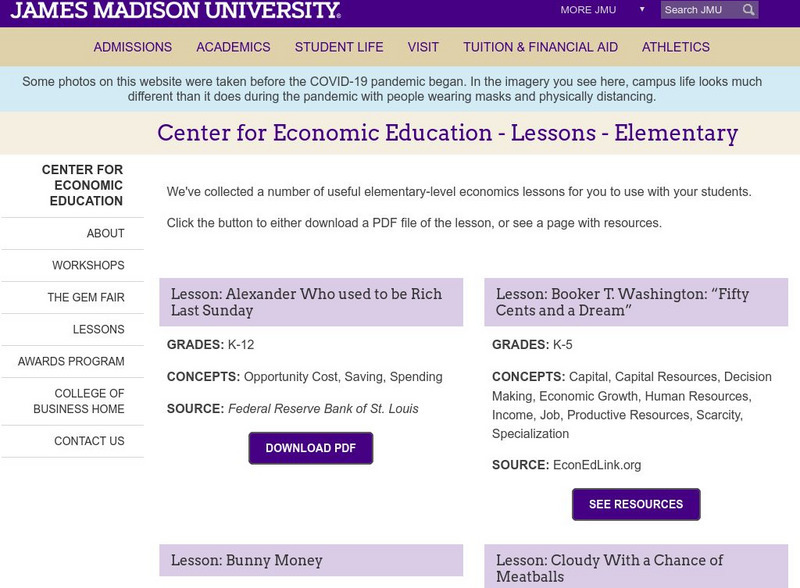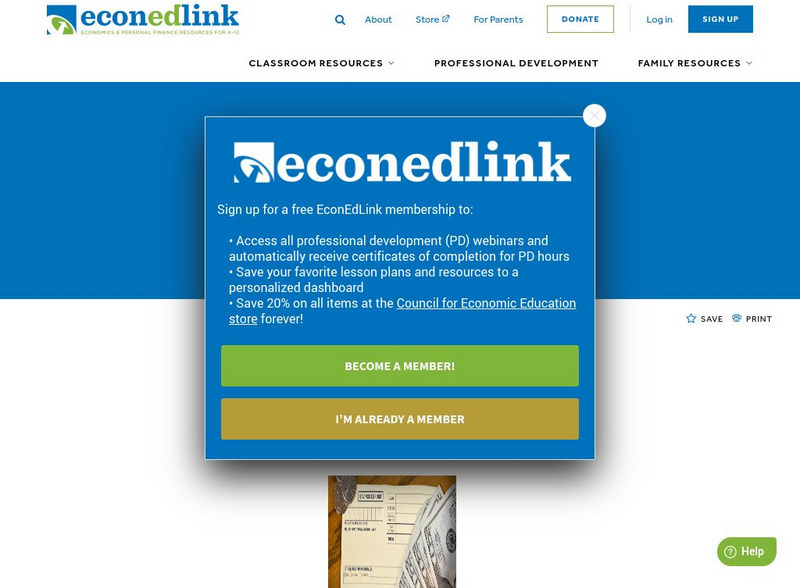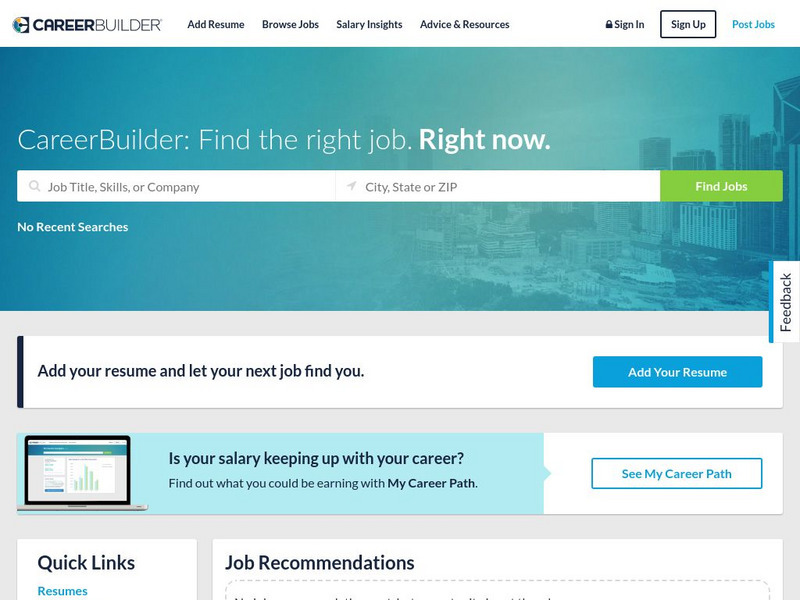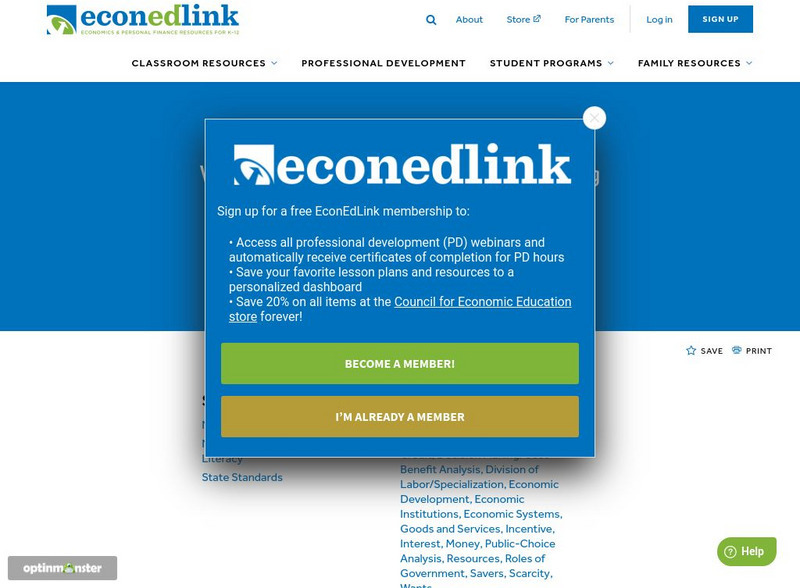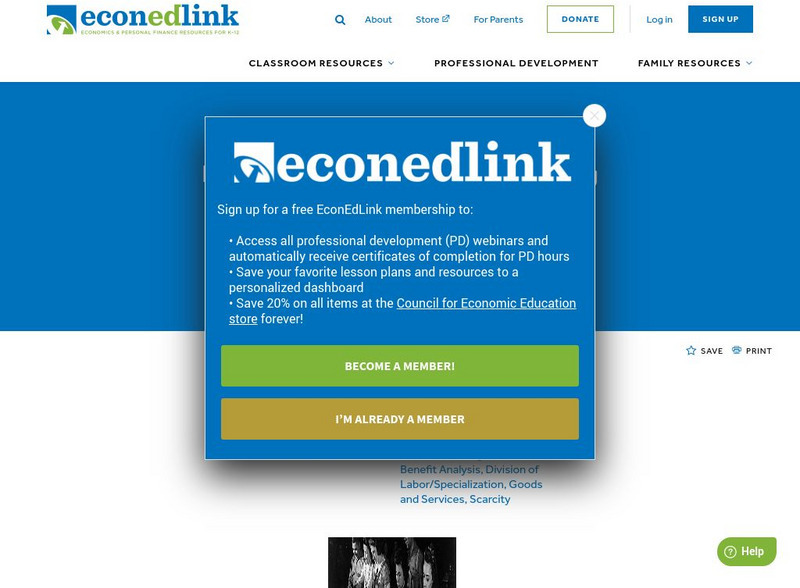Edutopia
Edutopia: Goods and Services [Pdf]
A unit that teaches the difference between goods and services, the difference between producers and consumers, the difference between human, natural, and capital resources, and the difference between bartering/trading and buying/selling....
James Madison University
James Madison University: Online Elementary Economics Lessons
James Madison University has developed a variety of online economic lessons for elementary students. Explore basic economic and financial concepts.
PBS
Pbs Learning Media: Write Now! Career Writing Prompts: Director, Human Resources
WLVT PBS 39 and PSEA have teamed to create these innovative writing prompts on careers. This 1-minute video provides an opportunity for students to learn a bit about a career as a Director of Human Resources, and to write feedback to the...
Council for Economic Education
Econ Ed Link: Banks, Bankers, Banking
This lesson is a simulation of opening a bank. Students are assigned various roles to play within the banking business. Students learn about the role banks play in a market economy.
Federal Reserve Bank
Federal Reserve Bank of St. Louis: Tortilla Factory [Pdf]
This lesson accompanies a story by Gary Paulsen called Tortilla Factory, and teaches students to identify the different types of resources (human, capital, natural, etc.) that go into creating corn tortillas and other products.
Investopedia
Investopedia: Human Capital
This explanation of human capital makes clear the importance of the skills of employees as a business asset.
Other
Career Builder
Search hundreds of thousands of jobs ? across the nation or in your own neighborhood. Explore the Career Builder Database to search jobs by keyword, job category, company, or industry.
Council for Economic Education
Econ Ed Link: The Shoemaker's Tools
This lesson incorporates the folk tale of The Shoemaker and the Elves to teach your students about the concept of capital resources. Lesson contains a link to an animated retelling of this beloved classic. Use it to have students...
Council for Economic Education
Econ Ed Link: Destination: Mars
Look up! Can you ever imagine standing on another planet and looking down at earth? We've been to the moon - now lets launch an expedition to Mars. Imagine all the preparation you will have to go through in order to have a safe and...
Council for Economic Education
Econ Ed Link: Music, Maestro, Please: Show Business and the Factors of Production
The city of Philadelphia, Pennsylvania recently opened a $300 million dollar center for the performing arts, the Kimmel Center. This lesson was developed for a special teacher workshop to incorporate economics and the arts to teach kids...
Council for Economic Education
Econ Ed Link: Why Work Now?
Why do people work so hard? Why aren't you just assigned a job that you are interested in and get paid as much as the next guy? This lesson will show you why employers want the best workers that their money can buy!
Council for Economic Education
Econ Ed Link: Work, Earnings and Economics: Using Lyddie by Katherine Paterson
In reading and discussing Lyddie, by Katherine Paterson, students examine basic economic concepts and explore the growth of labor unions and the role of government in a market economy.
Council for Economic Education
Econ Ed Link: A Fair Wage
Income for most people is determined by the market value of the productive resources they sell. What workers earn depends, primarily, on the market value of what they produce and how productive they are.
Council for Economic Education
Econ Ed Link: Human Resources and Capital Resources: It's a Match!
Learners will define and identify human resources and capital resources workers use in their jobs.
Council for Economic Education
Econ Ed Link: What Do Other People Want to Be?
In this lesson, students will graph people's job choices and identify which jobs would have the most competition based on the data.
Council for Economic Education
Econ Ed Link: Booker T. Washington:"fifty Cents and a Dream"
Young Booker T. Washington had a dream. That dream was to use the resources at his disposal to earn the money necessary to get an education that would allow him and others to become financially secure. This lesson based on the picture...
Council for Economic Education
Econ Ed Link: Mystery Workers: Productive Resources
This website focuses on productive resources which are divided into three categories, natural, human, and capital.
Other
Induction To: Human Resources Outsourcing
Provides a slideshow on the pros and cons of outsourcing labor.
Council for Economic Education
Econ Ed Link: Those Golden Jeans
Check out this informative economics lesson plan designed to review the three productive resources--natural resources, human resources, and capital resources--needed to produce goods and services.
Council for Economic Education
Econ Ed Link: Economic Spotter: Resources During World War Ii
In World War II pennies were made of steel and zinc instead of copper and women were working at jobs that men had always been hired to do. Why? Because during war times, scarcity forces many things to change!
Council for Economic Education
Econ Ed Link: Economic Spotter: Resources During Wwii
This is a lesson that deals with scarcity during WWII. Natural, human, and capital resources are discussed.
Council for Economic Education
Econ Ed Link: Henry Ford and the Model T: A Case Study in Productivity (Part 2)
Henry Ford's use of mass production strategies to manufacture the Model T revolutionized industrial manufacturing. This 3-part learning unit provides students with the story of Henry Ford and the Model T from an economics perspective....
Council for Economic Education
Econ Ed Link: The Economics of the Family Farm
Learn about the status of farming as a career, investigate the management of a family farm, and examine one recent farm crisis in this instructional activity.
Alabama Learning Exchange
Alex: Employer/personnel Issues
The class will discuss issues relating to employer/personnel. They will work together in groups to write a guide for new employees. They will also create a classroom policy handbook.


![Edutopia: Goods and Services [Pdf] Activity Edutopia: Goods and Services [Pdf] Activity](https://d15y2dacu3jp90.cloudfront.net/images/attachment_defaults/resource/large/FPO-knovation.png)
